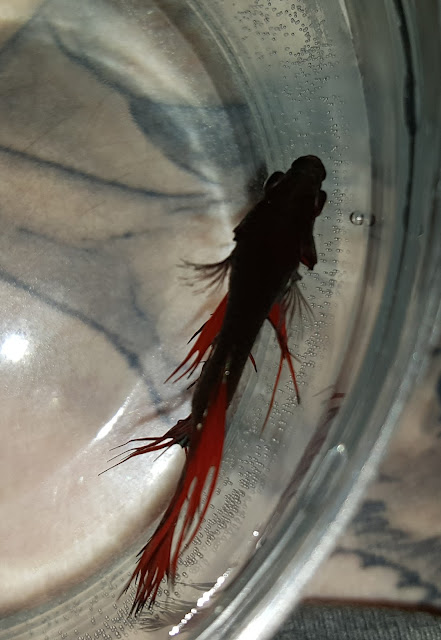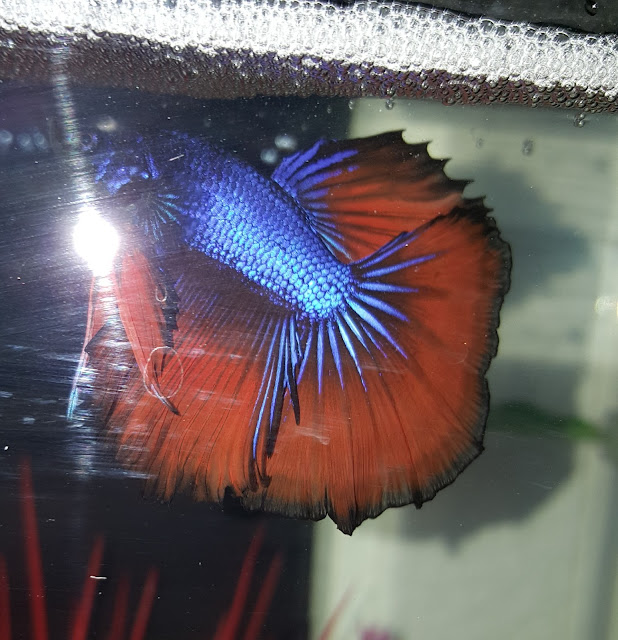Swim Bladder Disease
So Anakin has swim bladder disease.
It's not fun. But thankfully it's usually very treatable. But to diagnose and treat it you have to understand what the swim bladder is.
The swim bladder is a gas-filled organ that governs a fish's balance and buoyancy. When there's something wrong with it, you'll notice that your fish may be stuck at the surface or at the bottom of the tank, or have trouble remaining upright.
The way to treat it is to treat the cause. Most often, swim bladder disease is not, in itself, a disease. It's a symptom of an underlying condition. And to treat the swim bladder disease, you must treat the underlying condition.
The most common cause of swim bladder disease in bettas is constipation, which, thankfully, is among the easiest to treat. But you must examine your fish for other signs of illness. Look for lethargy, loss of appetite, pineconing, or dull colors. These may be indications of a very serious condition.
Usually, though, it's due to constipation. Which is what Anakin has. His belly is very bloated, he's very uncomfortable, and the poor guy just isn't having a good day.
So the first thing you do with a constipated fish is stop feeding him. Fast him completely, for 3 days. This does not harm the fish, it gives his digestive system a break and a chance to right itself.
Next, you may want to do daily epsom salt baths. I usually put the fish in a small plastic cup, like the one he came in or a small food grade tupperware container. First I fill it with water that is the same temperature as the water in his tank. Then I condition it and add about a teaspoon of epsom salts.
I'll add the fish and keep him there for about 15-20 minutes, and then put him back in his tank. I'll do this once a day while I fast him.
When I'm done fasting him, I'll feed him 1/4 of a blanched skinless pea.
You can use peas or Daphnia. Daphnia is preferred, since it's closer to their natural diet, but a pea will work, too.
To blanche a pea, you will boil it for about five minutes, then toss it into ice water until it's cool to the touch Then take the skin off, this is super important. They cannot digest the skin, your problems will be even worse if you give him the skin.
Once the skin is off, you will see that there are two halves inside. Take one of those halves and cut it in half again. This is what you will feed your fish, once you cut it into bite-sized pieces.
Feed him a quarter a pea twice a day. It's important to break his feedings up into smaller chunks. Feeding him a lot at once will not help.
Do this for about three days, or until all signs of constipation are gone. Then, you can slowly start replacing the peas with his regular pellets.
Do not give him bloodworms right now. Bloodworms are very rich and can cause constipation. You want to hold off on bloodworms for a week or two. Just stick to peas and pellets.
And it's a good idea to fast him one day a week even when he's healthy. Many betta owners do this as a preventative measure, to give their fish's digestive system a break. Feeding a pea once a week is a good idea as well. Just follow the instructions I gave. It can help keep them regular and prevent issues like this one.
With sound treatment and fasting, your fish will make a full recovery and his constipation, as well as his SBD, will be gone.
It's not fun. But thankfully it's usually very treatable. But to diagnose and treat it you have to understand what the swim bladder is.
The swim bladder is a gas-filled organ that governs a fish's balance and buoyancy. When there's something wrong with it, you'll notice that your fish may be stuck at the surface or at the bottom of the tank, or have trouble remaining upright.
The way to treat it is to treat the cause. Most often, swim bladder disease is not, in itself, a disease. It's a symptom of an underlying condition. And to treat the swim bladder disease, you must treat the underlying condition.
The most common cause of swim bladder disease in bettas is constipation, which, thankfully, is among the easiest to treat. But you must examine your fish for other signs of illness. Look for lethargy, loss of appetite, pineconing, or dull colors. These may be indications of a very serious condition.
Usually, though, it's due to constipation. Which is what Anakin has. His belly is very bloated, he's very uncomfortable, and the poor guy just isn't having a good day.
 |
| His fins are flared because he's scared and stressed, but you can see there are no signs of pineconing. |
 |
| And here you can see just how bloated and distended his belly is. Poor guy really is't having a good day. |
So the first thing you do with a constipated fish is stop feeding him. Fast him completely, for 3 days. This does not harm the fish, it gives his digestive system a break and a chance to right itself.
Next, you may want to do daily epsom salt baths. I usually put the fish in a small plastic cup, like the one he came in or a small food grade tupperware container. First I fill it with water that is the same temperature as the water in his tank. Then I condition it and add about a teaspoon of epsom salts.
I'll add the fish and keep him there for about 15-20 minutes, and then put him back in his tank. I'll do this once a day while I fast him.
When I'm done fasting him, I'll feed him 1/4 of a blanched skinless pea.
You can use peas or Daphnia. Daphnia is preferred, since it's closer to their natural diet, but a pea will work, too.
To blanche a pea, you will boil it for about five minutes, then toss it into ice water until it's cool to the touch Then take the skin off, this is super important. They cannot digest the skin, your problems will be even worse if you give him the skin.
Once the skin is off, you will see that there are two halves inside. Take one of those halves and cut it in half again. This is what you will feed your fish, once you cut it into bite-sized pieces.
Feed him a quarter a pea twice a day. It's important to break his feedings up into smaller chunks. Feeding him a lot at once will not help.
Do this for about three days, or until all signs of constipation are gone. Then, you can slowly start replacing the peas with his regular pellets.
Do not give him bloodworms right now. Bloodworms are very rich and can cause constipation. You want to hold off on bloodworms for a week or two. Just stick to peas and pellets.
And it's a good idea to fast him one day a week even when he's healthy. Many betta owners do this as a preventative measure, to give their fish's digestive system a break. Feeding a pea once a week is a good idea as well. Just follow the instructions I gave. It can help keep them regular and prevent issues like this one.
With sound treatment and fasting, your fish will make a full recovery and his constipation, as well as his SBD, will be gone.



Comments
Post a Comment